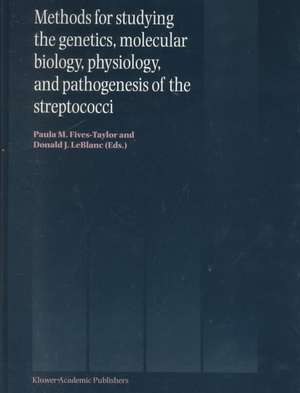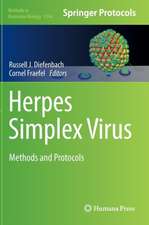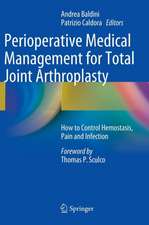Methods for studying the genetics, molecular biology, physiology, and pathogenesis of the streptococci
Editat de Paula M. Fives-Taylor, Donald J. LeBlancen Limba Engleză Hardback – 31 iul 1999
It is therefore hoped and expected that the advanced methods contained in this book will be of interest to those who work with the streptococci and other Gram-positive organisms, to researchers interested in industrial and medical microbiology and to any researcher who seeks to obtain a better understanding of how microorganisms interact with each other, their environment and their hosts.
| Toate formatele și edițiile | Preț | Express |
|---|---|---|
| Paperback (1) | 1104.13 lei 6-8 săpt. | |
| SPRINGER NETHERLANDS – 15 dec 2010 | 1104.13 lei 6-8 săpt. | |
| Hardback (1) | 1105.61 lei 6-8 săpt. | |
| SPRINGER NETHERLANDS – 31 iul 1999 | 1105.61 lei 6-8 săpt. |
Preț: 1105.61 lei
Preț vechi: 1163.80 lei
-5% Nou
Puncte Express: 1658
Preț estimativ în valută:
211.59€ • 218.58$ • 176.09£
211.59€ • 218.58$ • 176.09£
Carte tipărită la comandă
Livrare economică 25 martie-08 aprilie
Preluare comenzi: 021 569.72.76
Specificații
ISBN-13: 9780792358152
ISBN-10: 0792358155
Pagini: 256
Ilustrații: XVI, 256 p.
Dimensiuni: 210 x 297 x 18 mm
Greutate: 0.7 kg
Ediția:1998
Editura: SPRINGER NETHERLANDS
Colecția Springer
Locul publicării:Dordrecht, Netherlands
ISBN-10: 0792358155
Pagini: 256
Ilustrații: XVI, 256 p.
Dimensiuni: 210 x 297 x 18 mm
Greutate: 0.7 kg
Ediția:1998
Editura: SPRINGER NETHERLANDS
Colecția Springer
Locul publicării:Dordrecht, Netherlands
Public țintă
ResearchCuprins
Tn917 transponson mutagenesis and marker rescue of interrupted genes of Streptococcus mutans.- Site-specific homologous recombination mutagenesis in group B streptococci.- Targeted mutagenesis of enterococcal genes.- A lactococcal pWV01-based integration toolbox for bacteria.- Vectors containing streptococcal bacteriophage integrases for site-specific gene insertion.- Streptococcal integration vectors for gene inactivation and cloning.- Induction of transformation in streptococci by synthetic competence stimulating peptides.- Characterization of the lactococcal conjugative element pRS01 using IS946-mediated mutagenesis.- Use of electroportation in genetic analysis of enterococcal virulence.- Genetic transfer methods for Streptococcus sobrinus and other oral streptococci.- Isolation of enterococcal antigen-encoding genes from genomic libraries.- A simple microtiter plate screening assay for bacterial invasion or adherence.- End-probing: A non-radioactive approach to mapping transponson insertions.- A method for mapping phage-inducible promoters for use in bacteriophage-triggered defense systems.- Secretion of heterologous proteins by genetically engineered Streptococcus gordonii.- Examination of streptococcal gene expression in the mammalian environment.- Analysis of adherence-associated gene expression in Streptococcus parasangusis: A method for RNA isolation.- Development of an integrative, lacZ transcriptional-fusion plasmid vector for Streptococcus mutans and its use to isolate expressed genes.- Use of proteomics and PCR to elucidate changes in protein expression in oral streptococci.- The use of continuous flow bioreactors to explore gene expression and physiology of suspended and adherent populations of oral streptococci.- In vitro systems for investigating group Bstreptococcal: host cell and extracellular matrix interactions.- The rat model of endocarditis.- Lipoproteins and other cell-surface associated proteins in streptococci.- Growth of Streptococcal mutons in an iron-limiting medium.- Identification of oral streptococci using PCR-based, reverse-capture, checkerboard hybridization.- Pulsed-field gel electrophoresis as an epidemiologic tool for enterococci and streptococci.- Cell-based panning as a means to isolate phage display Fabs specific for a bacterial surface protein.









